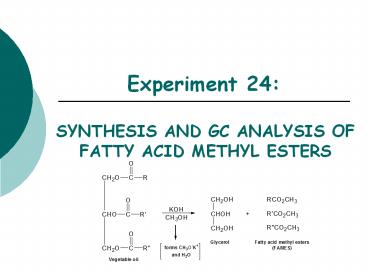Experiment 24: - PowerPoint PPT Presentation
1 / 19
Title:
Experiment 24:
Description:
Experiment 24: SYNTHESIS AND GC ANALYSIS OF FATTY ACID METHYL ESTERS Objectives: To synthesize fatty acid methyl esters through transesterification of an unknown ... – PowerPoint PPT presentation
Number of Views:160
Avg rating:3.0/5.0
Title: Experiment 24:
1
Experiment 24
- SYNTHESIS AND GC ANALYSIS OF FATTY ACID METHYL
ESTERS
2
Objectives
- To synthesize fatty acid methyl esters through
transesterification of an unknown vegetable oil. - To purify your product using column
chromatography. - To identify and analyze the purity of your
compound using TLC and GC analysis. - To identify the unknown oil based on fatty acid
methyl ester composition.
3
CHEMICAL EQUATION(Hydrolysis of a fat)
4
CHEMICAL EQUATION(Transesterification of
vegetable oil)
5
COMMON FATTY ACIDS
Saturated NO double bonds!
Monounsaturated ONE double bond!
Polyunsaturated gtone double bond!
6
SHAPES OF FATTY ACIDS
More cis double bonds more bent shape
7
OVERVIEW
- Synthesize FAMEs under micro reflux.
- Extract organic into hexane.
- Flush organic layer through SiO2 column to remove
polar impurities. - Perform TLC analysis and stain plate with 10
H2SO4 to ensure glycerol has been removed. - Submit GC sample for analysis.
- Identify and quantify FAMEs in product using GC
results. - Compare composition to p. 203 to identify unknown
vegetable oil.
8
EXPERIMENTAL PROCEDURE(Synthesis)
- Add 10 drops of unknown oil and methanol to a
reaction vial with stir bar. - Add 1M KOH/methanol.
- Place vial in heat block and begin stirring the
solution. - Attach reflux condenser.
- Heat to reflux. Maintain temperature b/n
70-80oC for 30 minutes. (Excessive heat will
ruin experiment!) - Cool flask to room temp.
9
EXPERIMENTAL PROCEDURE(Purification and
Isolation)
- Extract product
- 2X with hexane
- MODIFICATION
- SKIP 91 hexane diethyl ether step!
- After each extraction step, pass organic layer
through SiO2 column into a small test tube. - Proceed to PRODUCT ANALYSIS.
10
EXPERIMENTAL PROCEDURE(Product Analysis)
- TLC Analysis
- Perform analysis of product along with provided
standards of the unknown oil and FAMEs solutions. - Must use 10 H2SO4 stain with heat in order to
visualize spots. - Have stained TLC plate inspected by lab
instructor to ensure polar impurities have been
completely removed. - GC Analysis
- With instructor permission, prepare sample for GC
analysis.
11
GC ANALYSIS OF FAMES STANDARD SOLUTION
- Once returned, identify and quantify FAMEs
present in your unknown oil. - Compare these results to table on p. 203 in
order to identify your unknown oil.
12
Table 24.1 TLC Results
Be sure to give CENTIMETER measurements for ALL
spots and give measurement for SOLVENT FRONT on
this diagram!
13
Table 24.2GC Results
Compound GC Retention Times (min) GC Retention Times (min) Area Percent Adjusted Area
Compound Standard Sample Area Percent Adjusted Area
pentane XXX
Methyl Palmitate
Methyl Oleate
Methyl Linolate
Methyl Stearate
14
RELATIVE COMPOSITION OF OILS
Name of Oil Saturated Fatty Acids Saturated Fatty Acids Saturated Fatty Acids Total SFUs Monounsaturated Fatty Acids Polyunsaturated Fatty Acids Total PUFAs
Name of Oil Myristic C14 (140) Palmitic C16 (160) Stearic C18 (180) Total SFUs Oleic C18 (181D9) Linoleic C18 (181D9,12) Total PUFAs
Corn 0 11 2 13 28 58 59
Olive 0 13 3 16 71 10 11
Peanut 0 11 2 13 48 32 32
Soybean 0 11 4 15 24 54 61
Safflower 0 7 2 9 13 78 78
Cottonseed 1 22 3 26 19 54 55
Palm 1 45 4 50 40 10 10
15
Table 24.3 Expected vs. Experimental Results
Use the values from p. 203 here!
Use YOUR values from Table 24.2 here!
Fatty Acid Type Expected Relative Fatty Acid Composition Experimental FAMEs Composition Proposed Oil Identity
SFA
MUFA
PUFA
16
SAFETY CONCERNS
- CAUTION
- SULFURIC ACID and POTASSIUM HYDROXIDE are very
corrosive! - HEXANE and DIETHYL ETHER are extremely
flammable! - METHANOL is very flammable and toxic!
17
WASTE MANAGEMENT
- All liquid waste in container labeled ORGANIC
WASTE (FAMEs). - Leave TLC plates with instructor.
- Place filter papers in the yellow SOLID WASTE
can. - Place used TLC capillaries, SiO2 columns, and
glass Pasteur pipets in broken glass container.
18
CLEANING
- Rinse all glassware with wash acetone ONLY!
- DO NOT return any glassware to lab drawer dirty
or wet! - Be sure to return the stir bar to the flask!
19
In-lab Question (The following question should
be answered in laboratory notebook.)
- Draw the structures of the 3 fatty acid methyl
esters which would result from the following
transesterification































